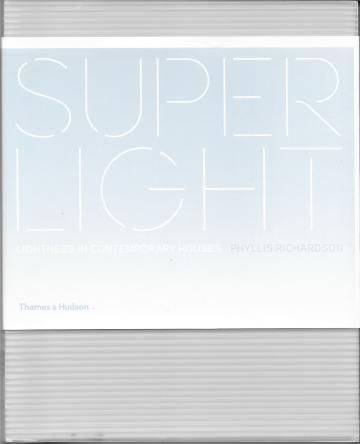
Superlight: Lightness in contemporary houses is a fantastic introduction to progressive design, with a focus on sustainable and ‘light’ architecture.
But before getting to the contents of Superlight, its own design is well worthy of attention. Instead of a thick cardboard cover adorned with an image from within the book, Superlight’s cover is made of two pieces of unfinished corrugated plastic sheet. The spine is bound normally but lacks the cardboard/perfect layer that covers the inside edges of the paper. This leads to an extremely lightweight book that has an exposed, modern feel to it. A simple paper sleeve, half the size of the cover, completes the stylish design.
Within the unusual cover is a treatise on ‘lightness’ as a design factor in architecture. The introduction describes how every house included manages to “open a debate” on lightness in surprising ways, from the first home floating on a lake in Canada to the final forest refuge made from cardboard logs in Japan. Superlight extols the virtues of lightness in every stage of the construction process, from transportation to renewable energies to design efficiency, and the houses in this book exemplify cutting edge innovative thinking.
The aim of achieving lightness in houses comes down to a range of factors, but those that Superlight best mounts a case for are sustainability, economics and spatial efficiency. All of the houses in this book have been built in locations where traditional construction would be either too impactful on the environment or unsuited to the space available. The property of lightness has been observed by the architects so as to create houses that may not fit the mould of a traditional house but are more mindful of their surroundings.
Superlight is divided into five sections with each focusing on a different element of lightness; ‘Floating’, ‘Low Energy’, ‘Urban Light’, ‘Escape’ and ‘Extreme’. Between seven and nine examples fill each section with plenty of variety in the countries and design influences on display. A larger proportion of the featured buildings are from either Japan or the USA, but examples range from Australia and New Zealand to Belgium and China.
Wood has a recurring presence throughout the book, as may well be expected in a discussion of light construction. The section entitled ‘Floating’ has a particular focus on wood as a structural material due to its light weight and corrosion resistance as compared to other options. Houses such as the ‘Exbury Egg’ (16), a single room temporary structure, showcase the capability of wood to outperform alternatives such as steel or concrete in scenarios where density is a factor. All of the houses in this section use lightness in their minimal contact to the ground, whether via water or lifted on stilts above uneven surfaces.
The ‘low energy’ houses all aim for carbon neutrality in construction and to generate the energy requirements of the house themselves. There is a large focus on the Solar Decathlon competition in the US, whose entrants have provided four of the houses in this section. The desire to achieve maximum energy efficiency has led to houses with a pronounced post-modern style, with the fabric-clad CHiP house (82) and the Hivehaus (102), built from hexagonal modules, among the most distinctive visually. There are also examples of recyclability in these houses, from shipping containers to parts of other houses reused into a new dwelling.
‘Urban Light’ focuses on the limitations that urban spaces can present and the steps that architects can take to, in spite of these limitations, still achieve a house of surprising lightness within their city environment. Some notable examples include the House NA (124) in Tokyo, which boasts a full glass frontage and multiple levels and half levels in an inventive interior layout, and the Casa Nuñez (146), with its distinctive fabric roofing. These dwellings showcase the ability of architects to adapt to a restrictive environment while still creating houses that fully embody lightness.
Construction in rural areas, however, brings with it its own challenges, and so the section on ‘Escape’ focuses on attempts to minimise the impact of the house on its surroundings. Houses on sleds, cantilevered on pillars or designed for easy assembly by anybody all manage to reduce the impact on the environment by eliminating the necessity for heavy equipment or intrusive roads. The Beachcomber (188) is a particularly elegant example, with two large runners beneath it on which it can be moved via winch or tractor. Located in an area prone to erosion, the house can be placed where it may least impact its surroundings.
‘Extreme’ houses of lightness are those that require light construction. Disaster relief housing, low socio-economic areas and locations too remote for traditional construction can all benefit from the qualities of light houses. Houses embodying the qualities that Superlight describes are ideal for prefabricated construction, as shown in the N4+ Gluebam House (228) in China or the Mamelodi Pod (232) in South Africa. An alpine hut at the top of Mt Elbrus in Russia (212) needs to be airlifted to its location and so a lightweight construction is required. These constructions are some of the most daring and innovative of those included in the book.
Superlight offers a view into a side of design that does not aim for the large, the grandiose or the self-important. Instead the quality of lightness that has been applied to all of the houses chosen by Richardson is characterised by personality, mindfulness and a commitment to a sustainable architecture. Superlight is a book that contains many new and exciting design features and shows a passion for challenging preconceptions on what a house is or has the potential to be. Richardson is well at the forefront of the next generation of design.
